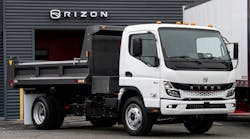The best alternative option for tractor-trailer fleets operating along set routes — terminal to terminal, or warehouse/factory to distribution center and back — is liquefied natural gas (LNG) at this point. Though building an LNG refueling station is still exceedingly pricey (anywhere from $350,000 to $1 million) and LNG-powered daycabs cost twice as much as even their '07-compliant diesel-powered brethren ($200,000 and up), it's still a fuel that offers diesel-equivalent power with fewer emissions and lower cost per gallon.
Pacific Gas & Electric is one fleet using LNG-powered daycab tractors in distribution operations. The fleet operates five Kenworth Class 8 T800 highway models powered by a 450-hp. Cummins ISX engine. Developed by Canadian company Westport Innovations, the engine is equipped with high-pressure direct injection technology.
The LNG tractor's range hovers between 400 to 450 mi. while reducing greenhouse gas emissions by 15 to 20% over equivalent diesel-fueled vehicles, cutting oxides of nitrogen (NOx) by 75%, and costing 25% less per gallon compared to diesel. PG&E notes that LNG replaces 95% of the diesel fuel typically consumed by these Class 8 tractors. The remaining 5% is a B20 biodiesel blend that acts as an igniter to get the LNG to burn under the high compression method used by diesel engines.
The main drawback to using LNG is the cost of building a refueling facility and the extra technology required for a Class 8 tractor to keep the gas super-cold so it liquefies (-260 deg. F). The advantage, however, is that LNG can offer nearly diesel-equivalent range for a distribution tractor-trailer.
Also, a range of tax credits and grants are available to commercial truck operators at both the federal and state level (www.afdc.energy.gov/afdc/fuels/natural_gas_laws_federal.html). For example, fleets can get a tax credit worth up to $30,000 for refueling infrastructure, a 50¢ per gal. tax rebate, and excise tax credits for buying natural gas-powered vehicles.
If the costs for switching to LNG prove too high for distribution fleets, a simpler change to B20 blended biodiesel can reduce emissions. Though biodiesel can cost more per equivalent gallon compared to petroleum-based diesel and results in a 1 to 2% fuel economy loss, no extra technology is required for use in model year 1998 trucks and up. Trucks older than 1998 may need their fuel hose lines changed as the biodiesel can degrade them over time. Safeway, the nation's third-largest grocery chain, switched to B20 biodiesel for most of its 1,000 trucks in January and expects to reduce carbon emissions by 75 million lbs. a year.
Several other spec'ing changes can also help boost a tractor's green profile as well, including using wide base tires on the unit's drive axles (along with the trailer) to reduce total vehicle weight. Aerodynamic cabs combined with fuel skirts and streamlined bumpers can improve fuel efficiency 1 to 2% by cutting drag at highway speeds, while automated mechanical transmissions (AMT) consistently shift gears at the most fuel-efficient engine rpm — helping the truck gain at least a minimum of 0.1 mpg.


